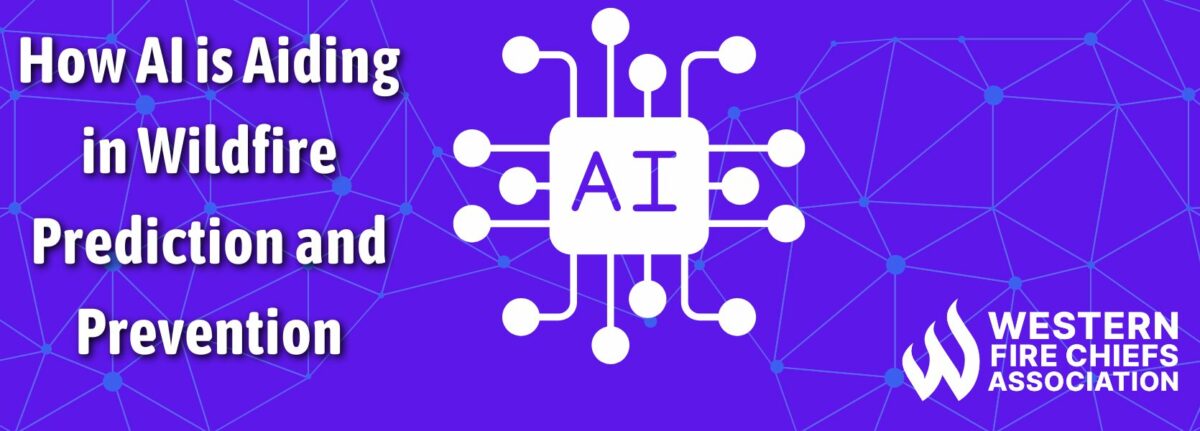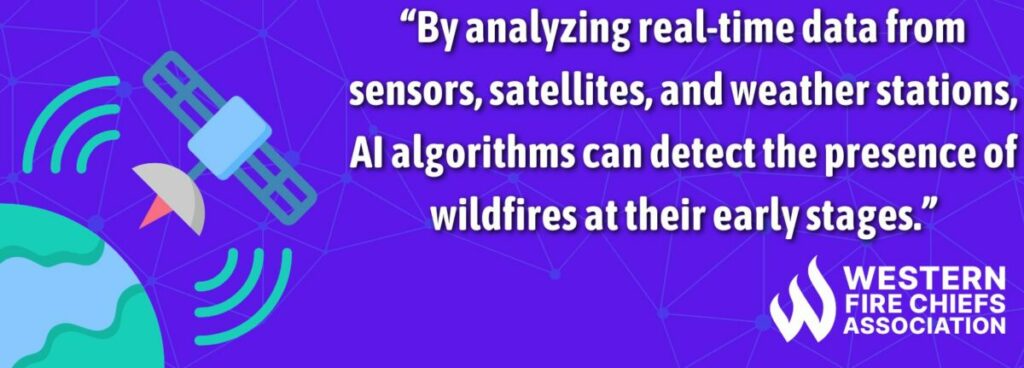Fire Pit Safety Tips
Stay safe around the campfire with tips from the Western Fire Chiefs Association. Learn essential precautions and practices for a worry-free outdoor campfire.
Explore the role of AI in wildfire prediction with guidance from the WFCA. Learn how advanced algorithms and data analytics enhance early detection and response.
Published:April 9, 2024
Edited:April 8, 2024

Explore the role of AI in wildfire prediction with guidance from the WFCA. Learn how advanced algorithms and data analytics enhance early detection and response.
As wildfires continue to pose a significant threat to communities around the world, the role of artificial intelligence (AI) in wildfire prediction and prevention has become increasingly crucial. By harnessing the power of data analysis and machine learning, AI empowers us to identify high-risk areas, predict fire behavior, and provide early warnings.
Prior to advanced technology, the process of predicting a wildfire was very tedious and time-consuming. Fire service personnel would analyze historical data on past wildfires to gain insights into wildfire patterns and trends. A common method is the utilization of fire weather indices, such as the Fire Weather Index (FWI) system. This system considers various factors such as temperature, humidity, wind speed, and precipitation to assess the risk of wildfires.2 Another approach involves monitoring fuel moisture levels, which refers to the amount of moisture present in the vegetation. When the fuel becomes drier, the likelihood of a wildfire occurring increases. Many traditional methods of wildfire prediction heavily rely on empirical and statistical methods developed using the same factors as the FWI system.1
Traditional wildfire prediction methods face challenges due to reliance on historical data, limited spatial and temporal resolution, difficulty integrating real-time data, oversimplification of wildfire dynamics, uncertainty. Additionally, there are issues with inadequate communication and coordination. Historical data may not reflect current conditions, and models often lack precision in predicting wildfire location and timing. Integrating real-time data is problematic, and models may oversimplify complex wildfire dynamics. Uncertainty and variability further complicate predictions, while communication and coordination among stakeholders are often insufficient. Advanced technologies such as machine learning and remote sensing offer potential solutions to improve accuracy and effectiveness in wildfire prediction and management. These technologies harness vast amounts of data and enable more precise modeling and monitoring of wildfire behavior.

Artificial Intelligence (AI) is playing a crucial role in revolutionizing wildfire prediction and management. Through the utilization of advanced machine learning algorithms, AI is able to analyze vast amounts of satellite imagery and aerial data to detect and classify fire hotspots. This enables early detection and rapid response to potential wildfires. AI algorithms can monitor the spread of fires in real-time. This provides valuable insights to emergency responders and helping them make informed decisions. AI also aids in predicting fire behavior by analyzing historical data and current environmental conditions. By considering factors such as weather patterns, fuel moisture levels, and topography, AI models can provide accurate predictions on fire growth and direction.4 This information is invaluable for planning evacuation routes, allocating resources, and minimizing the impact of wildfires. AI-powered systems can integrate data from various sources, such as weather stations, remote sensors, and even social media, to provide a comprehensive understanding of the wildfire situation. This enables emergency management agencies to have a holistic view of the evolving fire scenario and make timely and effective decisions.3
In order to prevent wildfires effectively, it is important to first be able to predict where they are likely to occur, as previously discussed. By pinpointing these high-risk areas through AI systems, officials can implement preventative measures, such as targeted vegetation management, prescribed burns, and public awareness campaigns. AI is also employed in the development of early warning systems. By analyzing real-time data from sensors, satellites, and weather stations, AI algorithms can detect the presence of wildfires at their early stages.4 This allows for faster response times, as authorities can be alerted promptly, and appropriate resources can be deployed to contain the fires before they spread. Additionally, AI is used to enhance fire detection and monitoring. Through the analysis of satellite imagery and aerial data, AI algorithms can identify fire hotspots and track the progression of wildfires. This enables firefighters to have a better understanding of the fire’s behavior and make informed decisions regarding firefighting strategies.4
AI is being used in various ways in the fire service, including the usage in fire detection systems. AI algorithms can analyze data from sensors, cameras, and other monitoring devices to quickly identify the presence of fires. This enables early detection, allowing firefighters to respond promptly and minimize the spread of the fire. Additionally, AI assists in emergency response coordination. AI-powered systems can integrate data from various sources, such as emergency calls, traffic conditions, and resource availability. They optimize response times and resource allocation during fire incidents.6
Stay safe around the campfire with tips from the Western Fire Chiefs Association. Learn essential precautions and practices for a worry-free outdoor campfire.
Discover essential firework safety tips to ensure a dazzling display without accidents. Learn how to celebrate responsibly with expert guidance from WFCA.
Explore the role of AI in wildfire prediction with guidance from the WFCA. Learn how advanced algorithms and data analytics enhance early detection and response.